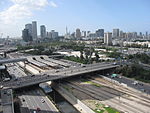Al-Jammasin al-Gharbi
AC with 0 elementsArab villages depopulated during the 1948 Arab–Israeli WarDistrict of JaffaPages with non-numeric formatnum arguments

Al-Jammasin al-Gharbi was a Palestinian Arab village in the Jaffa Subdistrict. It was depopulated during the 1947–48 Civil War in Mandatory Palestine on March 17, 1948. It was located 6.5 km northeast of Jaffa.
Excerpt from the Wikipedia article Al-Jammasin al-Gharbi (License: CC BY-SA 3.0, Authors, Images).Al-Jammasin al-Gharbi
HaZohar, Tel Aviv-Yafo Bavli
Geographical coordinates (GPS) Address Nearby Places Show on map
Geographical coordinates (GPS)
| Latitude | Longitude |
|---|---|
| N 32.092777777778 ° | E 34.797222222222 ° |
Address
HaZohar 2ג
6230231 Tel Aviv-Yafo, Bavli
Tel Aviv District, Israel
Open on Google Maps









